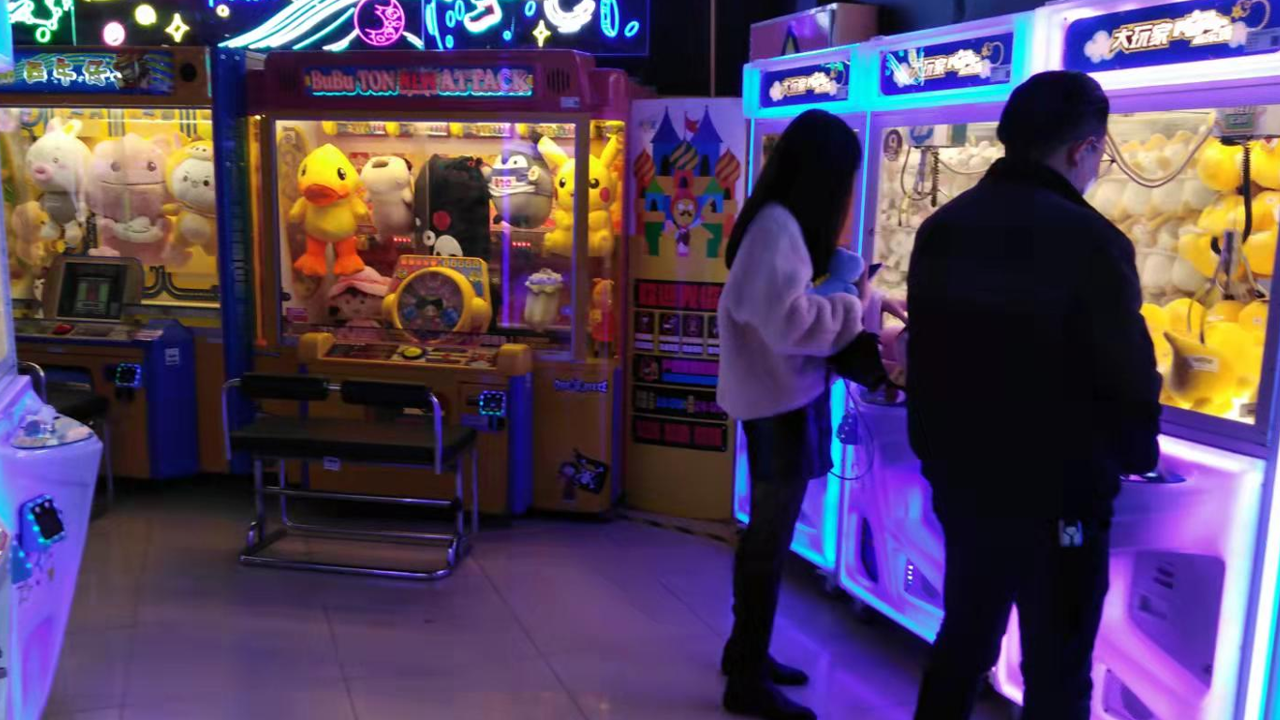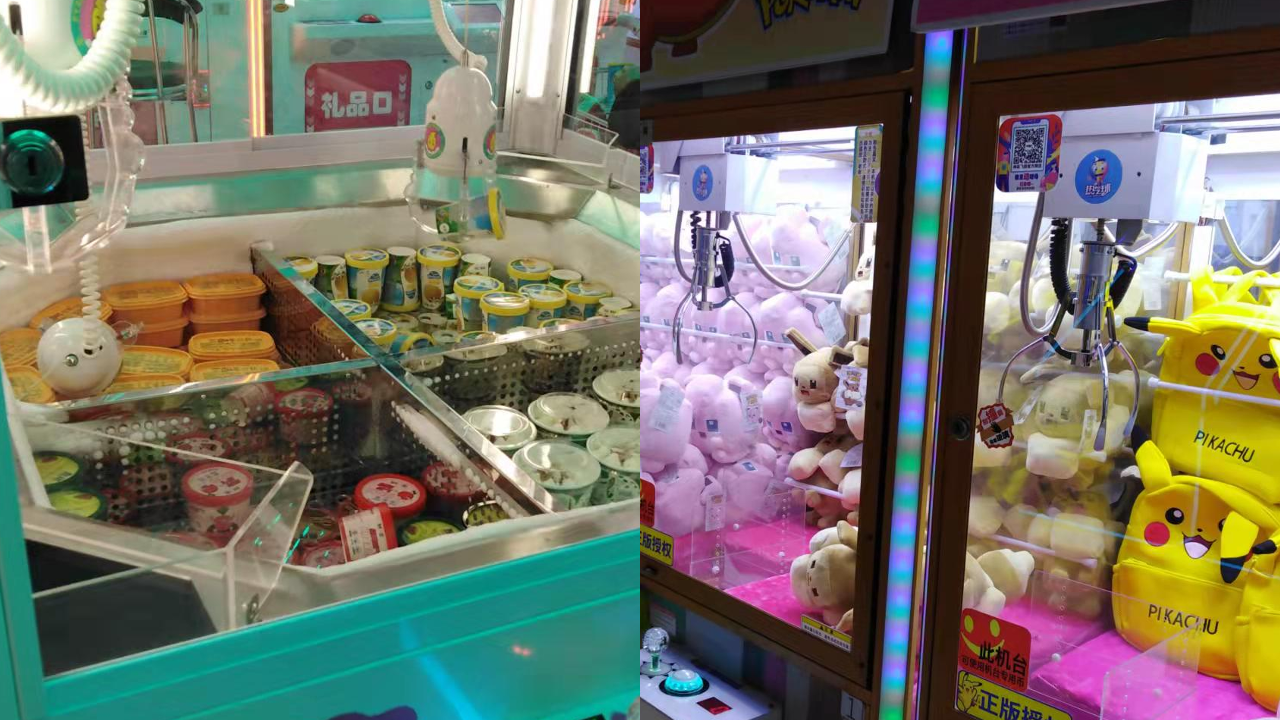A Brief Tour of the Chinese Arcade Scene
Play King of Fighters with a minion, win an Eevee for your sweetie, or just play a tiny round of bowling — the choice is yours

For all the fame that Japanese arcades have acquired over the years, I think that Chinese arcades are even more significant. The government banned the importation of arcade machines along with all other video game hardware in 2000, but arcade machines were welcomed back into the country years before home consoles. This made the arcade an important part of the reintroduction of video games into China, and they remain popular to this day.
Arcades come in all shapes and sizes here. A few are standalone businesses — usually found in entertainment/shopping districts nestled among milk tea shops, clothing boutiques, and food stalls — but most are found in shopping centers and malls. Some of these are no more than a few machines in a nook or lining a walkway, while others can be quite sizable and elaborate. There’s a lot of variety in the decor and naming as well, which ultimately signals if a particular arcade is meant more for young children or for teenagers and young adults.

Then, of course, there is the heart of the beast: the machines. I’ve written just a little bit about some of the more eclectic machines to be found in Chinese arcades, but the variety is quite remarkable, especially in the larger standalone arcades. As far as conventional machines go, the most common are racing games and rail shooters. These tend to be large, attention-grabbing machines featuring unusual technical features and/or branding from popular action film or video game licenses. This is the least of what they feature, however.
This is not intended to be a list of every noteworthy arcade system one might see in China. That list would include a range of oddities — combination playhouse/arcade cabinets for small children, redemption machines that bear a disturbing resemblance to video slots, old-school shooting galleries with actual balloons and darts, some things that I can only guess are modern strength testers — that I may need to look into for future articles. For now, let’s take a walk through a typical arcade — or rather several of them, located in different cities in the central PRC.

The crane game
For all the flash and technology on display, the most common sight by far is a classic of the midway. The pictures tell the tale — walk into any arcade in the country and you’ll see row after row of crane game cabinets, potentially rooms full of them at larger facilities. Some smaller “arcades” are just crane machines, one or two dozen of them crammed into an available space.
Crane games and variants therein are oddly important in Chinese gaming culture. People actually record each other playing these things, and it’s not without reason. There are some Chinese internet personalities who made a name for themselves due to their apparent ability to consistently win prizes from these cabinets. And by the way, those prizes are a varied lot — stuffed animals are certainly the most common, but one might also see machines containing snack foods, ice cream, even child-sized backpacks.

It’s not too hard to understand why crane game machines are so common and so popular. In China, arcades are a common dating location for college students. As old-fashioned as it might seem, being able to win a prize for your sweetheart has a special allure. The one time I won at one of these machines, I handed the little stuffed animal over to the young lady I was with, and it was touching.

The crane game is not the only prize dispensing machine that’s prevalent in China — they come in a range of sizes and types. One that’s pretty common in arcades aimed at younger children is Japanese-style gacha machines that dispense figurines in plastic capsules. The toys that come out of these machines are very culture-bound and some of them probably don’t exist outside of the region. This one, for example, dispenses figurines of Pikachu dressed as characters from the classic Chinese novel Journey to the West.
Another variant on the crane game involves steering a pair of scissors to cut a string. This game, I gather, is nearly impossible (if not actually impossible) to win. To increase the appeal, these games hold big-ticket prizes, including giant stuffed animals and even sizable Lego construction sets.
VR machines
Virtual reality machines are becoming increasingly common in malls in China. You see them not just in arcades, but on display in high-traffic central areas. Most of these — including those in arcades — are not “games” as they are purely passive experiences, meant to simulate roller coaster or helicopter rides.

VR machines vary in size. The smallest are pod-shaped seats that can accommodate a single user at a time, and these are the ones most common outside of arcades. The largest resemble amusement ride cars and can accept a half-dozen people at once. These are the most elaborate ones, featuring hydraulics and “4D” elements for greater immersion.
As far as proper games go, there are two types that are somewhat common. The first are ride-on motorcycle games. Arcade racing games are already very popular here, and adding a headset and some haptic feedback elements can help them stand out. The other type is a full-size recreation of a home VR game. These can be set to run a few different games, but usually, they are running Beat Saber or some similar rhythm game.

Rhythm games
Speaking of which, rhythm games are still very popular, though they’ve been mixed up a bit in the years since the Dance Dance Revolution phenomenon. While you will still see the occasional DDR clone, most rhythm games in current Chinese arcades are played with the hands rather than the feet. Usually, these feature either a series of pads around a screen that the user must smash when instructed. Others feature molded components meant to resemble drums or other percussion instruments. The songs featured in these machines are usually KTV standards that would be very familiar to the people playing them.
Speaking to their popularity, rhythm games are often found near the entrance to arcades, clearly visible to passers-by. They are meant to get people in the door.
Physical games
Now we come to the disappointing part: I have never seen Skee-Ball in a Chinese arcade. I can’t say that it doesn’t exist here, but this American arcade standard is certainly not commonplace. Instead, there are two other physical interface games that take its place.

The first are basketball games, and these are extremely common — larger arcades can easily have a dozen or more of them. These games somewhat resemble the self-returning free throw games you’ve likely seen in bars back home, but these are more elaborate. In most of them, the hoops are motorized and will begin to move if the player scores enough points in a short period of time. Land enough points and the time is extended, and a good player can keep the game going until he is too physically spent to continue.
It’s not hard to understand the appeal of these machines. Basketball is easily one of the most popular sports in China, and these games give a lot of would-be ballers the chance to show off for their girlfriends.

The other game is mini-bowling, and this is the one that comes the closest to Skee-Ball. There’s not a lot to explain here — it’s bowling, but everything is scaled down. While this particular game is a full installation, there are also standalone mini-bowling cabinets designed with smaller arcades in mind. Mini-bowling tends to be more popular with children, as everything is scaled to their size.
There are various other physical interface games one might find in a Chinese arcade, including air hockey and any number of traditional non-electronic games. It’s worth noting that billiard clubs are growing in popularity in many parts of the country, so it’s not unusual to see a few pool tables tucked away in the back of a larger arcade.

Arcade emulators
In an earlier article, I said that one doesn’t see old-school arcade cabinets in Chinese arcades, but this is only partially true. No, you’re not going to see Galaga, but what you may find are arcade system emulators. While these aren’t given as much space as racing games or rail shooters, you’ll see a few wherever you go, especially in smaller arcades and lounges. Usually, these are based around an emulation of SNK hardware and can run a variety of games from the '90s.

The size and design of these emulators vary greatly. They are usually sit-down machines that are much smaller than true arcade cabinets, with the smallest ones being roughly the size of a suitcase. Some are designed with the old-school arcade aesthetic in mind, but others have more fanciful cases, clearly intended to catch the attention of children.
Most Chinese arcade emulators can accommodate two people at a time. While the ones above appear to be single-player, these are actually head-to-head cabinets in which each system connects to the opposite one, allowing each player to have their own screen. These cabinets are fixed to play a specific game, usually some iteration of King of Fighters or another fighting game.
Mini-KTV
You won’t find these in every arcade in China, but they are easily the most Chinese thing on the list. For those who are unaware, KTV is something better known in the West by its Japanese appellation, karaoke. KTV is the predominant social activity in the country, for any group you care to name — friends, couples, families, businesses, you name it. This isn’t the bar karaoke with which Americans are familiar — these businesses are divided into private rooms, some of which can easily hold over a dozen people.
KTV isn’t always accessible, though. For one, renting a room can be expensive, especially for college students, and during busy times they may be completely booked. Even with money and time, one might not have enough people available to make it worthwhile, as these are meant for parties.

Enter mini-KTV, a somewhat common sight in shopping centers. Each booth is a few feet per side, designed to accommodate two people though one could certainly cram more in. Inside each booth is a screen from which the user can select the song of their choice. The booths are pretty good at trapping sound — not that anyone is going to hear your bad singing over the din of the arcade, anyway.
Special features
Larger, more permanent arcades will often have a special feature or two that are meant to be big draws. These tend to be installations, semi-custom setups designed with the layout in mind. The mini-bowling setup from earlier was one such installation. Here’s another:

This miniature go-kart track fills a significant part of the floor space in this arcade. The course is child-scale and the tiny cars won’t seat anyone older than about seven or eight. It takes all of twenty seconds to run a lap, though the skills of the kindergarten-age drivers will slow that down a bit. It’s pretty puny compared to the outdoor go-kart tracks one might see in an American amusement center, but it’s still a real eye-catcher — after all, who was expecting to see this in a mall arcade?
Take a stroll through the arcades featured in this story:
Source: YouTube.
